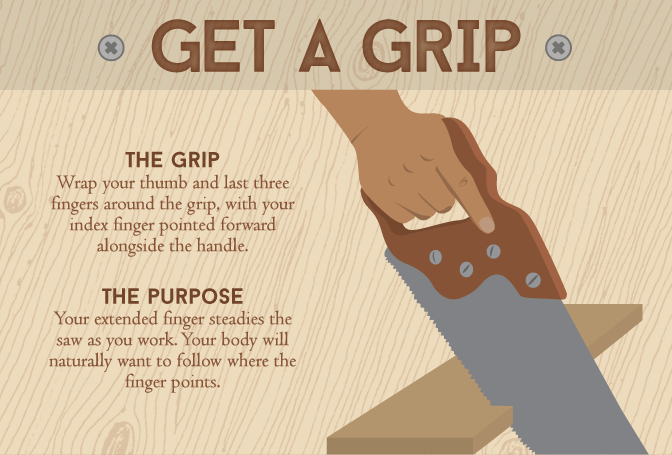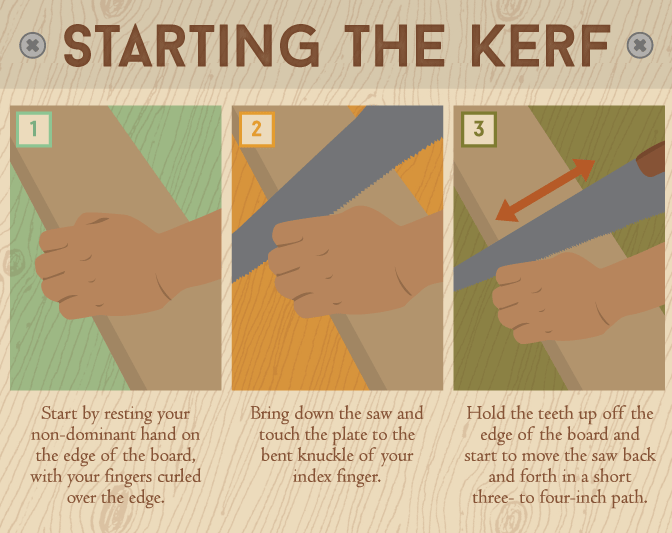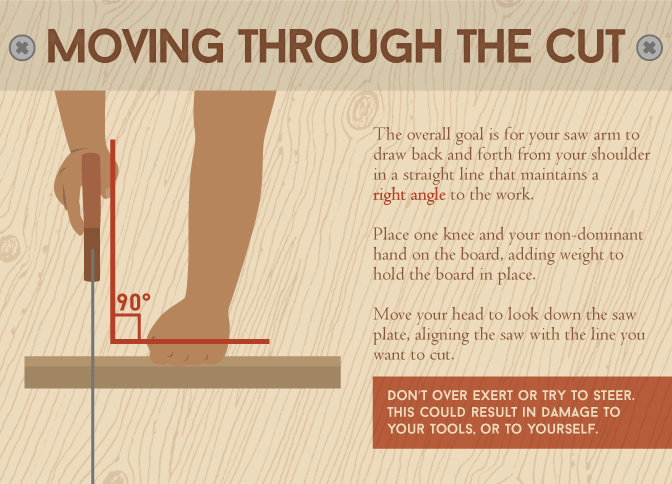A Sight for Saw Eyes
How to Safely and Effectively Use a Handsaw
A few weeks ago, I was helping my brother put up a fence around his backyard.
This involved burying lots of four-by-four posts in the ground. To solve a problem
toward the end of the project, we needed to saw one of the eight-inch posts in half.
I pulled a post from the pile and weighed my options. I could spend fifteen minutes
gathering supplies and safety gear to fire up my circular saw, or I could spend a minute
marking the cut and using the handsaw I keep in my toolbox. Not a difficult decision.
I use hand tools a lot in my furniture shop. I have a level of comfort and familiarity
with them that many people accustomed to power tools have never developed. That confidence
made choosing the quick handsaw over the circular saw or table saw easy – but later that day, I watched my
brother struggle to use the same saw. He was making a few critical mistakes that affected
the whole experience. I spent a few minutes showing him the basics I’m going to share with you now.
A Sharp Tool is a Useful Tool
Is your saw sharp? Cutting wood with a dull saw is like cutting a tomato with a dull knife:
impractical and dangerous. Old saws are made to be sharpened with a triangular file,
but if you’re not interested in learning that skill, consider the new saws available on store
shelves that come sharp. The downside of a shiny new saw is that these days, the teeth are case-hardened.
This means the metal has been tempered, so once the saw is dull it cannot be re-sharpened,
and must be replaced. Fortunately, new handsaws are also fairly inexpensive. So while you do have to replace the entire saw once dull, the price point often still makes this a more attractive option than replacing circular saw or table saw parts.
Getting a Grip
The next consideration is your grip on the handle.
A proper grip wraps the thumb and last three fingers
around the grip with your index finger pointed forward,
resting alongside the handle, like making an imaginary gun with your fingers.
The extended finger keeps the handle from rotating in your hand as you work,
and your body will naturally want to follow where the finger points. This will help you saw straight.

You also want to have a firm but gentle grip on the saw, as if you were holding a baby bird.
A vise-like death grip on the handle will tense the muscles in your forearm and will twist your
grip and the saw off center, making it more difficult to saw in a straight line. Use a gentle
grip and concentrate on drawing the saw back and forth in a straight line.
A good saw is smarter than the user; trust the saw to follow your layout marks,
because trying to “steer” the saw in the cut only ends in frustration.
Starting the Kerf
Starting the cut is the most important part of the whole operation. The move I
see most often is to drop the saw teeth on the board’s edge and briskly pull the saw backward,
making a small trough to start the cut. The brrrip sound is satisfying, but the technique
is flawed and inaccurate, because you’re removing wood with the dull side of the teeth – which makes
the saw, and your starting mark, difficult to control. Whether your saw is designed to cut on the push or
the pull of the blade, good technique will get you into the kerf quicker and straighter.
Start by resting your non-dominant hand on the edge of the board, with your fingers curled over the edge.
Keep your fingers tight together, including the thumb, and move it close to the line you want to cut. Then bring down
the saw and touch the plate to the bent knuckle of your index finger. Be careful not to run the teeth of the saw along
your finger, or you will get scratched or cut; your knuckle should touch the plate above the teeth. This
creates side-to-side stability as you start the cut.
Hold the teeth up off the edge of the board and start to move the saw back and forth in a short,
three- to four-inch path . Then slowly lower the teeth to the wood. The first contact between saw and
wood should be like making light scratches to the corner of the wood. Then, like stepping on a car’s gas pedal,
slowly allow more of the weight of the saw into the cut and increase the length of your sawing motion until you have
a good kerf started. At this point, I will often move my hand a few inches away and begin moving the saw through the wood faster.

Moving Through the Cut
The minutia of how you grip the saw and when you start the cut are all for nothing if you don’t
pay attention to what your body is doing overall as you make the cut. It’s important to remember
that the goal is to allow your saw arm to draw back and forth from your shoulder in a straight
line that maintains a right angle to the work.
Position the board at a comfortable height. Low sawhorses, roughly knee-high,
are ideal in most cases. A picnic table seat works well in a pinch. Place one knee
and your non-dominant hand on the board. This adds weight to hold the board in place
and puts your body in a stable three-point stance. With your non-dominant hand near the
saw plate as described above, move your head to sight down the saw plate with your
dominant eye, lining up the saw with the layout line.

The most important part of using a handsaw is to maintain your body position so your sawing arm
can move in line with the cut. If you lean one way or the other, it will translate through your cut.
Don’t try and exert strength into the cut or steer the cut; you could injure yourself, ruin the cut ,
or bend and kink the saw plate. Let the weight of the saw do the work, and maintain a smooth motion,
using most of the length of the saw.
Wrapping Up
From throwing a baseball to shooting a gun , learning the correct technique
and body mechanics for a physical activity is important for good performance. Sawing is no different.
Set yourself up correctly, and the whole process is straightforward and easily repeated. The biggest contributor to good
performance is practice; the more you use a handsaw, the better your results will be.
The handsaw in your toolbox isn’t there to replace its electric cousins.
Power tools excel at repetitive tasks, but they take time to set up and extra safety
precautions to use. A handsaw will save you time and effort with its grab-and-go style.
Embed the article on your site

